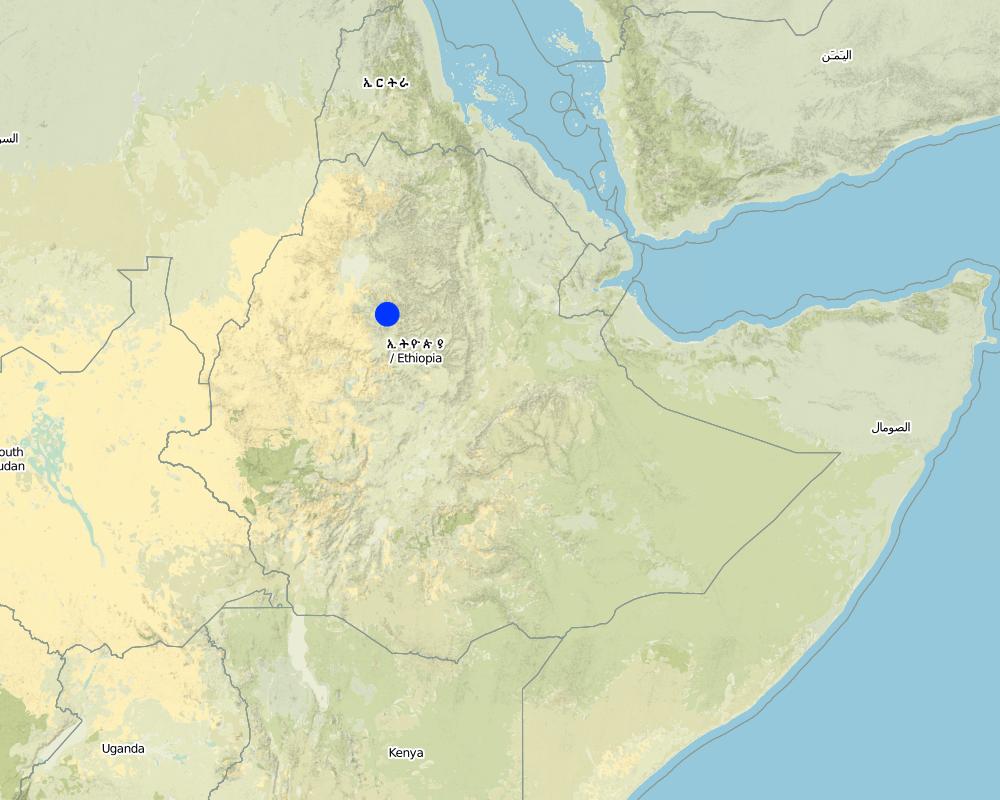Self Help [埃塞俄比亚]
- 创建:
- 更新:
- 编制者: Philippe Zahner
- 编辑者: –
- 审查者: Fabian Ottiger
approaches_2386 - 埃塞俄比亚
查看章节
全部展开 全部收起1. 一般信息
1.2 参与方法评估和文件编制的资源人员和机构的联系方式
SLM专业人员:
Muhamed Ahmed
Office of Agriculture
Hulet Eju Ennesse, Amhara
埃塞俄比亚
有助于对方法进行记录/评估的机构名称(如相关)
Swiss Agency for Development and Cooperation (DEZA / COSUDE / DDC / SDC) - 瑞士有助于对方法进行记录/评估的机构名称(如相关)
SNNPR Bureau of Agriculture - 埃塞俄比亚1.3 关于使用通过WOCAT记录的数据的条件
编制者和关键资源人员接受有关使用通过WOCAT记录数据的条件。:
是
2. SLM方法的描述
2.1 该方法的简要说明
A household and the family members work on SLM measures to manage their land without external support.
2.2 该方法的详细说明
该方法的详细说明:
Aims / objectives: Self-help approach explains the responsibility taken by a land user household to undertake SLM activities on the land he is holding using his and the family labor, without incentives provided from external sources. It aims at enhancing household land users’ responsibilities for managing their land so that they will be able to increase land productivity and improve the livelihoods. This approach is as old as communities and farming. Land users cultivating on steep slopes practiced SLM activities using this approach for many years. The approach area is defined by administrative and watershed units.
2.5 采用该方法的国家/地区/地点
国家:
埃塞俄比亚
区域/州/省:
Amhara
Map
×2.6 该方法的开始和终止日期
注明开始年份:
2000
2.7 方法的类型
- 基于项目/方案
2.8 该方法的主要目的/目标
The Approach focused mainly on SLM with other activities (water harvesting, grazing land management, forest development)
To enhance household responsibilities in the management of land, improve land productivity and efficiency of labor
The SLM Approach addressed the following problems: shortage of trained manpower to provide adequate technical advice, support the households at the time of planning and implementation. Causes of the problem are: 1) Indirect: lack of knowledge, lack of enforcement of legislation, land subdivision and 2) Direct: over-exploitation of vegetation, agricultural causes and overgrazing
2.9 推动或妨碍实施本办法所适用的技术的条件
机构设置
- 阻碍
Inadequate emphasis given to implementation compared to the plan
Treatment through the SLM Approach: Attention should be given to action on the ground
法律框架(土地使用权、土地和水使用权)
- 启动
The existing land ownership, land use rights / water rights moderately helped the approach implementation: the farmer has use rights that encorages for proper management of that specific plot
了解SLM,获得技术支持
- 阻碍
lack of skilled power to implement the approach
Treatment through the SLM Approach: enhance the skill of support staff
其他
- 阻碍
Lack of integration of SLM with other agricultural activities
Treatment through the SLM Approach: provision of improved inputs
3. 相关利益相关者的参与和角色
3.1 该方法涉及的利益相关者及其职责
- 当地土地使用者/当地社区
Working land users were mainly men (Family members of the household working together)
Actual work with responsibility. The approach involved disadvantaged people because one who do not implement the approach and conserve his/her land will be land less.
- 国家政府(规划者、决策者)
providing technical support
3.2 当地土地使用者/当地社区参与该方法的不同阶段
| 当地土地使用者/当地社区的参与 | 指定参与人员并描述活动 | |
|---|---|---|
| 启动/动机 | 互动 | Public meetings: land users undertake SLM activities on their own plots |
| 计划 | 互动 | Training: At any time in the year but most commonly in the dry seasons before the onset of rains |
| 实施 | 自我动员 | family labor: engaged any time their involvement is needed |
| 监测/评估 | 互动 | Field visits: development agents and group leaders make field visits to evaluate the activities |
| Research | 无 |
3.4 有关SLM技术选择的决策
具体说明谁有权决定选择要实施的技术:
- 主要是土地使用者,由SLM专家提供支持
解释:
This approach is prepared by land users because at the time of last approach/ mass mobilization where all are working in one watershed the other area was damaged. So some farmers decided to work on ther lands with their families.
Decisions on the method of implementing the SLM Technology were made by mainly by land users supported by SLM specialists. the one assigned as an expert is responsible in facilitating implementation schedual.
4. 技术支持、能力建设和知识管理
4.1 能力建设/培训
是否为土地使用者/其他利益相关者提供培训?:
是
明确受训人员:
- 土地使用者
- SWC specialists
培训形式:
- 在职
- 示范区域
涵盖的主题:
general and frequent traing and followup
4.2 咨询服务
土地使用者有权使用咨询服务吗?:
是
指明是否提供了咨询服务:
- 在土地使用者的土地上
- 在固定中心
说明/注释:
Name of method used for advisory service: Training and visit; Key elements: training, demonstration, followup; 1) Advisory service was carried out through: government's existing extension system; Extension staff: mainly government employees 2) Target groups for extension: land users; Activities: planning, surveying, constructio and evaluation
Advisory service is inadequate to ensure the continuation of land conservation activities; there should be further empowerment through training
4.3 机构强化(组织发展)
是否通过这种方法建立或加强了机构?:
- 是,非常
具体说明机构的强化或建立程度:
- 本地
具体说明支持类型:
- 能力建设/培训
4.4 监测和评估
监测和评估是该方法的一部分吗?:
是
注释:
bio-physical aspects were regular monitored through observations; indicators: number of farmers practising SLM measures
bio-physical aspects were regular monitored through measurements; indicators: amount of work done
technical aspects were regular monitored through observations; indicators: quality of work
economic / production aspects were regular monitored through observations; indicators: extent of work done
area treated aspects were regular monitored through measurement
There were no changes in the Approach as a result of monitoring and evaluation
5. 融资和外部物质支持
5.1 该方法中SLM组成部分的年度预算
注释(例如主要的资助来源/主要捐助者):
Approach costs were met by the following donors: government (national): 3.0%; local community / land user(s) (-): 97.0%
5.4 信用
是否根据SLM活动的方法给予信用值?:
否
6. 影响分析和结论性陈述
6.1 方法的影响
该方法是否帮助土地使用者实施和维护SLM技术?:
- 否
- 是,很少
- 是,中等
- 是,支持力度很大
maintenance and expansion of the technology
Did other land users / projects adopt the Approach?
- 否
- 是,很少
- 是,中等
- 是,支持力度很大
Almost all land users used this approach because it is easy to adapt with the local condition.
6.3 方法活动的可持续性
土地使用者能否维持通过该方法实施的措施(无外部支持的情况下)?:
- 不确定
若否或不确定,请具体说明并予以注释:
there is a problem of in provision of adequate training, inputs. In some cases there is a problem of dipossing exess water safely therefore it needs a closed technical support and follow up
6.4 该方法的长处/优点
| 土地使用者眼中的长处/优势/机会 |
|---|
| decrease lands that can be degraded more and improve the production of land (How to sustain/ enhance this strength: training, follow up) |
| 编制者或其他关键资源人员认为的长处/优势/机会 |
|---|
| improve the attituede of farmers on conservation works (How to sustain/ enhance this strength: it shoud be supported through training, motivation/ rewarding and follow up) |
7. 参考和链接
7.1 方法/信息来源
- 实地考察、实地调查
- 与土地使用者的访谈
链接和模块
全部展开 全部收起链接
无链接
模块
无模块


